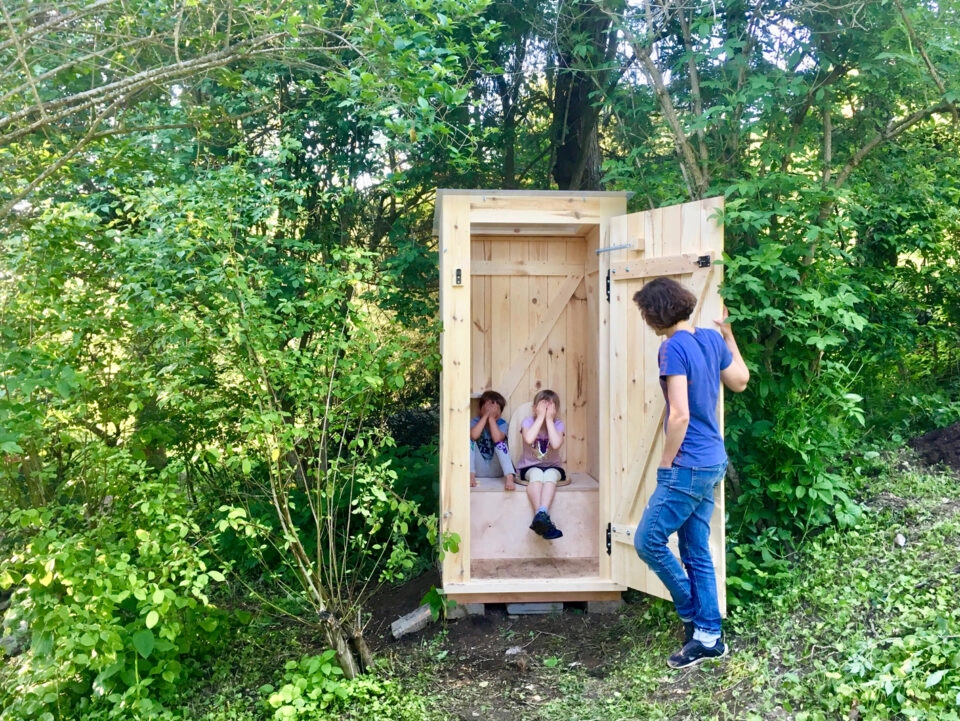"Mum, I have to pee"
Having to use the toilet in places that do not have one is an unpleasant matter, even for many adults. However, when the unpredictable needs of young children have to be taken into account, the issue becomes even more challenging. Parents and teachers alike are confronted with having to organise a practical solution for a long outdoor trip or stay where access to conventional toilets may not be guaranteed at all times. In the following, we will give you some tips and advice on how to use a toilet when travelling with children in a way that is both eco-friendly and as stress-free as possible for everyone involved. Furthermore, we will discuss how remote places in nature, such as forest gardens, forest kindergartens or similar facilities without water and electricity can be equipped with a child-friendly toilet.
Out and about in nature and not a loo in sight
It is worth mentioning, that reminding children to use the toilet at home before leaving the house is a well-known and effective strategy to delay the next visit to the toilet. It is just as obvious to make tactical stops at motorway service stations, restaurants, etc. so that sanitary facilities there can be used if necessary.
However, these tips are only helpful to a limited extent. For short excursions, such as a walk in the forest, this may be perfectly fine. For longer trips and outings in nature, however, it is only a matter of time before children (and adults too, of course) need to go to the toilet for number one or number two. Our tips and advice on this subject are based on three guidelines:
- Act as environmentally friendly as possible and without leaving any trace behind.
- Respect the needs and privacy of children
- Be sanitary and clean
When spending long periods of time with your children away from toilet facilities, it may be inevitable that they have to relieve themselves in an outdoor environment. Adults may be able to control their needs until a restroom is available, but again, this is not always the case. In the event that your children (or even adults) need to relieve themselves in nature, please bear the following tips in mind:
- Please ensure that urinating takes place at least 30 metres away from buildings, open water, rivers or streams. Also, do not pee in caves, crevices or directly on trees.
- For number two, an even greater distance from buildings, open water, rivers and streams should be kept, preferably as far away as possible. The faeces as well as the toilet paper used should not be left behind under any circumstances. Ideally, you should use a double sealed bag made of eco-friendly, biodegradable plastic to transport the waste in a hygienic and sustainable way.
- If you have to leave solid waste behind, you should dig a small hole and bury it. Be aware that this is an emergency solution. Pathogens can sometimes linger in the soil for a very long time, so this method should be avoided at all costs.
- Please note that sanitary towels and similar items should never be left behind or buried.
- Please disinfect your hands after going to the toilet!
Toilet solutions for forest kindergarten and more
After we took a look at how children could relieve themselves outdoors in the most sustainable way, we now turn our attention to your options when it comes to providing remote locations with child-friendly toilets.
If plots of land are not equipped with standard sanitation facilities in the first place, this can definitely cause a little trouble. Especially the lack of sewage or electricity connections may seem at first glance to be an impossible obstacle to overcome. Fortunately, however, there are several solutions that do not require access to any connections at all. Basically, you have the choice between the following options:
- Chemical toilets
- Dry toilets
- Urine-separating toilets
Chemical toilets, such as those used at large events or construction sites, are probably the most familiar option here, although they are not the best one. All excretions are caught inside the toilet and retained there. Chemical substances prevent the excreta from decomposing. As a result, no rotting process takes place, and that’s how odours are suppressed. Chemical toilets can only be emptied at special disposal stations, as faeces, urine and chemicals result in an extremely toxic combination. Chemical toilets are quite complicated to use due to their need for emptying stations. Furthermore, they have a negative impact on our environment due to the chemicals used. For this reason, dry and composting toilets are usually a more fitting solution, especially for nature- and environment-conscious facilities. More information on chemical toilets can be found here.
Dry and composting toilets are a sustainable method of using toilets without connections. Both dry and composting toilets do not need to use water at all, so there is no need for a sewer connection. There is a difference between dry and composting toilets in that composting toilets separate the solid and liquid excreta inside the toilet by means of a partition insert. This is what is happening in all TROBOLO toilet solutions, where a particularly effective separator is used to keep the excreta perfectly and hygienically apart. Since faeces and urine do not mix, but are caught in separate containers, odours are significantly reduced and can even be completely eliminated by using litter or an electric exhaust system. A TROBOLO is therefore completely odour-free in use. With both dry and composting toilets, there is also the option of composting the excreta and thus returning it to the ecosystem. TROBOLO composting toilets offer the alternative of emptying the contents of the filled liquid container into a conventional toilet and disposing of the solid waste, which is collected in an inlay inside the solid waste container, together with the household waste. All containers can be removed, transported and emptied hygienically and easily.
Ideal composting toilets for young children
From Day 1, forest kindergartens and similar educational institutions have been amongst the satisfied TROBOLO users. Because sustainability is very close to our hearts, we are pleased that our products offer the possibility for even the youngest children to experience sustainable processes and to internalise them from an early age. That is why we have designed some TROBOLO models especially for little children to use.
The TROBOLO KitaBœm, which can be used by both adults and toddlers, is suitable for outdoor use. The model consists of a toilet house inside of which, in addition to a composting toilet for adults, there is a second, smaller composting toilet for children aged 2 to 6 years. Thanks to the fitted separator, the children’s toilet is able to keep the excreta apart just as effectively as is the case with the toilet for adults. Like all our models, the TROBOLO KitaBœm is handcrafted from sustainable wood and can be used all year round, even in freezing temperatures.
If you are looking for a model for indoor use, we recommend our TROBOLO NinoBlœm. Unlike the TROBOLO KitaBœm, this model is designed exclusively for use by toddlers aged 2 to 6 years.
In addition to the connection-free use without electricity and water, the child-friendly composting toilets from TROBOLO offer additional benefits. Using the toilet is just as comfortable, easy and hygienic as using a conventional toilet. Due to the separation of solid and liquid excreta, the use of a TROBOLO is 100% odour-free and emptying can be done in a clean and hygienic manner. Even composting of the toilet waste is possible if you wish. Alternatively, you can easily and cleanly dispose of the excreta by placing the solid excreta including inlay in the household waste, similar to used diapers, and disposing of liquid excreta via a toilet with a water connection. The sustainable materials and the well thought-out design also make the environmentally friendly solutions from TROBOLO real eye-catchers.
Conclusion
Using the toilet on the move can be a real challenge. This is especially true when children are involved. However, by following our tips for wild toileting, you can ensure that even impromptu outdoor toileting is clean, hygienic and sustainable. If you are faced with the challenge of equipping a place without connection possibilities with sanitary facilities for small children, TROBOLO offers two suitable solutions with the TROBOLO KitaBœm for outdoor use and the TROBOLO NinoBlœm for indoor use, which you can use easily, self-sufficiently and sustainably. Numerous families, forest kindergartens and schools already rely on TROBOLO. You can find some interesting reports with pictures of satisfied users here. If you have any questions regarding your individual situation, please contact us for a competent consultation with our friendly team.
Always stay up to date.
Sign up for our newsletter here to never miss out on any news or free promotions.
Thanks for signing up to our newsletter.





